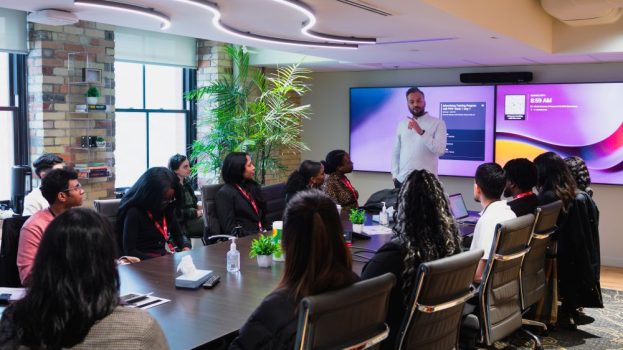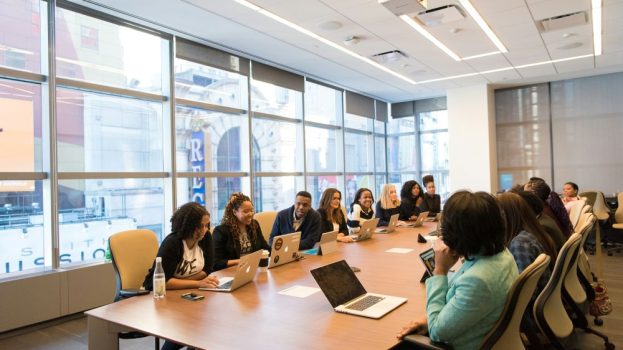Above: From the cover of the Summer 2021 issue of strategy. An illustration by Cecil Warner speaks to the crossroads brands and agencies must face – go deep with foundational change at the roots or shallow with performative acts at the surface.
This story originally appeared in the Summer 2021 issue of strategy.
Milestones, even those as grim as the murder of an innocent Black American at the hands of police, are often a good time to step back and take stock.
But Dr. Richard Williamson, who leads the Leadership and Inclusion course at Centennial College in Toronto, cautions against measuring progress against the one-year mark of George Floyd’s death. “We’re thinking that somehow there’s been all this movement or progress,” he says. “Unfortunately, this is not quick work.”
For years, Williamson has facilitated discussions on inclusive leadership among leaders from across Canada, giving him unique insight into their “thoughts, ideas, what they’re doing… and where they want to go next.”
From where he sits, a good number of companies have been quietly doing the work of diversity and inclusion for a while, accruing best practices and organizational knowledge, often at a slow but steady pace. In a way, that’s what worries him about the compressed timeline under which some companies reacted to Floyd’s death with statements of solidarity and promises to do better.
“There’s a huge risk that what they’re doing is really just window dressing – they’re not making structural changes,” he says. “This work is serious, it’s long term, it’s structural – it’s the entire culture of an organization. That doesn’t shift quickly or easily.”
If last year’s events have taught marketers and brands anything, it’s that achieving the foundational change needed – across hiring, retention, training, even marketing – will take time. It’s a process that must start from a place of listening and learning, Williamson says. Only then can brands play a positive role in helping shape cultural norms.
“Instead of reacting quickly and doing a couple of high-visibility things, it’s [about] committing to longer-term organizational learning. There really is a process of building through understanding. Without that, a lot is going to get missed.”
Putting systems in place
A first major step for a lot of organizations has been to put systems in place to help facilitate strategy development and implementation. For many, it has been a matter of appointing new functional DEI leadership, often at the VP level or higher.
While roles such as the chief diversity officer have existed within many large U.S.-based corporations for years, they remain relatively uncommon in Canada outside of the big banks and consultancies. But within the last year, Canopy, Indigo and Lululemon are some of the brands that have hired leaders with DEI mandates.
Other companies, such as Aldo and Sephora, have set up advisory councils or committees to provide oversight and ongoing leadership. Unilever first brought a DEI lens to its brand work in the mid-2000s, but it wasn’t until last year that it formed a DEI advisory council whose mandate spans employee training and development, supplier diversity, recruitment, employer brand and external partnerships, says Gina Kiroff, a director of marketing at the CPG.
Then there are companies like Hudson’s Bay, which has established a number of DEI groups and committees. The country’s oldest retailer hired its first divisional VP of DEI, formed a new DEI Council, created a DEI merchant group to improve representation of BIPOC designers and brands in its stores, and developed a marketing DEI committee to ensure its in-house talent, agency partners and marketing content reflect Canadian diversity.
 With an eye to the future, a number of companies are also rethinking their recruitment and retention strategies. For Scotiabank, student cohorts are an opportunity to help recruit a more diverse employee base, says global CMO Laura Curtis Ferrera.
With an eye to the future, a number of companies are also rethinking their recruitment and retention strategies. For Scotiabank, student cohorts are an opportunity to help recruit a more diverse employee base, says global CMO Laura Curtis Ferrera.
In May, the bank welcomed more than 400 students into corporate head office roles such as marketing, ensuring that 60% of them came from BIPOC communities and 55% of them were women. Ferrera says establishing such measures will help set up hiring practices on a go-forward basis and is a “singular opportunity to make a world of difference, since [the bank is] hoping to hire from those groups.”
As part of its own talent strategy, Hudson’s Bay wants to make it easier to attract, retain and advance top employees of diverse backgrounds, perspectives and identities, says president and CEO Iain Nairn. To that end, it has partnered with Equitek National Diversity Outreach, which helps Canadian corporations find qualified talent from underrepresented demos, as well as schools across the country.
Of course, recruitment is only the first step – creating and maintaining inclusive workplaces for underrepresented talent is equally important for retention. “There aren’t a lot of racialized senior marketers in Canada, and there’s always the argument, ‘Well, I don’t know anybody or there just isn’t the talent,’” says Mangala D’Sa, VP of marketing, category and digital experience at Aegis Brands. “The talent is here. It just hasn’t been elevated.”
Having recognized a disconnect between the makeup of its customers, franchisees and corporate employees, the former Second Cup parent co. is looking to bridge those gaps, D’Sa says. It’s a commitment that comes with looking at a much broader pool of candidates from different backgrounds and being as unbiased as possible throughout the recruitment process. “It’s very intentional, versus it being almost a checkbox of actions.”
Adopting a learning mindset
Setting up an advisory council and DEI leadership is a great place to start, says Williamson. But, more broadly, leaders must start by doing “a lot more listening,” he says. “We have to stop assuming our own thoughts, ideas and views of the world are the right ones.”
Founded in 1972 on the values of “love, integrity and respect,” Montreal-based Aldo is one company whose founder Aldo Bensadoun has long prioritized diversity and inclusion – even though “that’s not what it was necessarily called back then,” says Felisia Canedo, global PR manager, who also sits on the company’s DEI committee, which was formed last summer.
Still, the company continues on its own journey of learning as it re-evaluates the effectiveness of its policies and practices, engaging with employees through quarterly pulse-check surveys that help inform the next steps it will take as an organization. “What we’ve learned, especially with D&I, is that for all the learning that you have to do, there’s a lot of unlearning that also goes along with it,” says Canedo. “This type of mental shift takes time.”
 Elsewhere, companies are learning to leverage their employee resource groups (ERGs) by involving them in an array of business activities. Originating in the 1960s in the U.S., ERGs were imported into Canada through large multinationals, gaining greater prevalence over time. But within the last year, they have taken on new meaning, with companies like Indigo, Hudson’s Bay and Campbell either formalizing their resource groups or adding new ones. And leaders are recognizing how valuable of a resource they can be.
Elsewhere, companies are learning to leverage their employee resource groups (ERGs) by involving them in an array of business activities. Originating in the 1960s in the U.S., ERGs were imported into Canada through large multinationals, gaining greater prevalence over time. But within the last year, they have taken on new meaning, with companies like Indigo, Hudson’s Bay and Campbell either formalizing their resource groups or adding new ones. And leaders are recognizing how valuable of a resource they can be.
Mieka Burns, VP of marketing at the Campbell Company, says the CPG is working to empower its resource groups to “develop their own content, voices, frequency and cadence of meetings and to engage the broader Campbell’s team, including marketing, to discuss topics that we never would have discussed before, like white fragility and the Black experience and equality versus equity.”
Another way Campbell’s Canadian marketing team is working to create a more open and welcoming environment is by incorporating what it calls “I&D moments” into its weekly huddles, Burns says. “It has been an incredibly effective forum to share experiences and learnings – as broad as that sounds – various snippets of learnings and sound bites or thoughts that provoke dialogue in a way we never would have before.”
Meanwhile, Scotiabank is learning to better leverage its ERGs to help shape internal programming as well as its marketing programs. For example, during Black History Month in February, nearly 4,000 employees participated in a session led by the Black Employee Network and the bank’s global diversity and inclusion team.
“It’s involving everyone in the conversation as opposed to the leaders leading the conversation,” Ferrera says. “Now the conversations are happening in the middle, they’re happening at the front lines, and it’s filtering up, it’s filtering down.”
Last spring, when the marketing team set out to manually audit its communications, it spent more than 20 hours engaging with the ERGs, Ferrera says.
“To a group, they all said, ‘Nothing about us without us.’ So that became a mantra in our marketing. When we do something, we involve them – could be at the brief stage, could be early in the creative stage, but we’re using them as a sounding board, even in the creation of the scope of a project.”
 This approach to working hand-in-hand with ERGs is relatively new, though some companies have been doing it for some time in an “unconsciously skilled way,” says Williamson, describing the method as “inclusion in action.”
This approach to working hand-in-hand with ERGs is relatively new, though some companies have been doing it for some time in an “unconsciously skilled way,” says Williamson, describing the method as “inclusion in action.”
“You’re tapping into the knowledge and wisdom that employees have,” he says. “You can get enormous insights from people who may be further down that ladder, if you think of it in terms of a hierarchy. But you’re really tapping into human experience and knowledge that can come from any corner of the [organization].”
Fostering a culture of accountability
In the aftermath of George Floyd’s murder last May, hundreds of Canadian organizations committed to work towards an equitable society. As pressure mounted on brands to declare themselves allies in that fight, signing one’s name on a pledge or call to action became a highly visible way of demonstrating a deeper commitment to the cause.
To date, more than 400 companies have become signatories of the BlackNorth Initiative, which takes a business-first approach to ending anti-Black systemic racism by committing leaders and their organizations to specific actions. In the world of advertising, more than 90 agencies and clients have signed a Call for Equity circulated by the People of Colour in Advertising and Marketing (POCAM), whose goal is to “create omnipresent, meaningful conversations about equity, equality and diversity in the industry.”
“So much of what POCAM was recommending resonated with our strategy and aligned with our beliefs and the right intention, so it felt right to support their efforts,” says Burns, who personally signed the pledge on behalf of Campbell.
Beyond committing to change in writing, some companies are finding ways to create a culture of accountability within their organizations. At Campbell, for example, accountability is being built into each employee’s objectives – alongside business, project and performance metrics – based on the completion of training and education sessions.
“We want to make sure we’re establishing a baseline of common understanding, common knowledge, and common opportunity to learn more,” Burns says. Those accountability metrics are different for each employee, since part of the goal is for “everyone to build their own self-awareness and understanding of [DEI] concepts.”
 Brands are also beginning to show their commitment by diversifying their product assortments through partnerships and pledges. For example, last year, fashion retailer Harry Rosen worked with Black designer Patrick Assaraf and Toronto Raptors president Masai Ujiri on a capsule collection, with proceeds going to Black Youth Helpline. The retailer says it is actively looking to sign more diverse designers as part of an effort to make the fashion industry equitable.
Brands are also beginning to show their commitment by diversifying their product assortments through partnerships and pledges. For example, last year, fashion retailer Harry Rosen worked with Black designer Patrick Assaraf and Toronto Raptors president Masai Ujiri on a capsule collection, with proceeds going to Black Youth Helpline. The retailer says it is actively looking to sign more diverse designers as part of an effort to make the fashion industry equitable.
Elsewhere in retail, Indigo became the first Canadian retailer to sign the 15 Percent Pledge, committing last October to increase the representation of books by BIPOC authors, as well as BIPOC brands across its lifestyle products, to a benchmark of 15%.
With the goal of further highlighting diverse creators, the book retailer launched Mini Marche earlier this year. The shop-within-a-shop experience highlights kids and baby products from local businesses that identify as being BIPOC-, woman- and LGBTQ-owned or that are sustainability focused or philanthropic.
Joining a group of companies that includes West Elm and the Gap, Hudson’s Bay and Sephora Canada signed the 15 Percent Pledge in May, with the department store planning to have 15% of all new brands be BIPOC-owned or -designed by the fall. And by 2022, at least 15% of HBC’s design talent for its owned brand business will be BIPOC. Meanwhile, Sephora Canada will strive to have 25% of its offering be BIPOC-owned by 2026.
Beyond product assortments and employee training, one area in which accountability has become more important is within hiring and retention practices, as well as diversity at the senior executive level. To address the latter, companies like Unilever have committed to publicly disclosing race and ethnicity at the senior leadership level. (It also collects employee census and self-ID data, but doesn’t make those numbers public.)
Meanwhile, some brands are putting accountability in the hands of AI. Having completed a manual audit of its communications last spring, Scotiabank’s Ferrera says the process is too onerous to be done on an ongoing basis. So instead, the bank has partnered with Brainsights to do an always-on audit of its marketing and use AI and neuroscience to help overcome bias.
Other brands have partnered with Toronto-based Diversio, which offers an AI-driven platform that pulls in anonymous employee data on gender, race, ethnicity, sexual orientation, disability and mental health – tying it to data pertaining to employee experience and helping to identify systemic differences in the way employees experience the workplace. The software provides tailored recommendations – based on academic research conducted with the University of Toronto – that help address the unique DEI challenges the company might be facing. “Honestly, it’s not rocket science,” says Diversio co-founder and COO Anya Klimbovskaia. “But it keeps you accountable.”
In April, the company announced an inaugural cohort of 80 Diversio-certified companies, which includes Indigo, Hudson’s Bay, OLG, Accenture and Interac. To obtain certification, companies must commit to collecting employee data to identify bias and barriers faced by minority groups, measure and set targets to increase diversity at all levels, implement DEI-focused programs and policies, and commit to tracking results.
 Diversio co-founder and CEO Laura McGee says the idea for the certification came after seeing “no shortage of pledges and commitments” from business leaders and wanting to make it easier to identify those that are walking the talk.
Diversio co-founder and CEO Laura McGee says the idea for the certification came after seeing “no shortage of pledges and commitments” from business leaders and wanting to make it easier to identify those that are walking the talk.
“Data tracking and programming is really what it comes down to,” she says. “Not just throwing spaghetti at the wall and implementing whatever program happens to be top-of-mind.”
The companies in the inaugural cohort have shown they understand where bias exists, and have laid out a plan with programs or policies intended to unlock those challenges, McGee says.
For Williamson, making DEI progress comes back to having the right leadership mindset, one focused on long-term learning and humility. He says it’s about putting pride in its place and admitting, “I don’t know. I’m not clear yet. I need to do tons of learning. That’s what I’m going to embark on.”
“In Canada… there’s this natural tendency to avoid uncomfortable conversation and expose some vulnerability,” says Burns of the challenges that lie ahead. “But the realization as a leadership team, as people managers and as an organization, is that if we want to grow, we have to have conversations, listen, create these safe spaces proactively and educate ourselves. The challenge we face [going forward] is helping teams find courage to lean into uncomfortable conversations and lean into discomfort to a certain degree in order to grow and ultimately become better.”
























